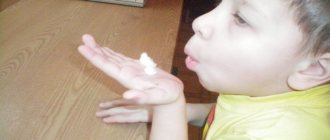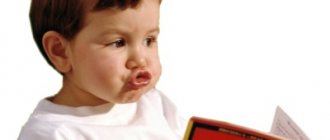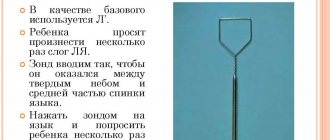Article:
Normally, by the age of 3–4 years, children correctly pronounce the hard and soft sound “s”.
Incorrect pronunciation is called sigmatism. If you notice that your child has errors in sound pronunciation, do not delay - contact a speech therapist. After all, the sooner a defect is corrected, the easier it is to get rid of it. In this article we will talk about the types of sigmatism, the features of the correction program and exercises for sound production that you can do with your son or daughter at home.
Forms of sigmatism
Sigmatism is a defect in the pronunciation of hissing and whistling sounds, in our case “s”. There are 4 forms of violation.
The first is sigmatism itself, when “s” is absent from speech.
The second is parasigmatism, that is, when “s” is replaced with another sound.
Variants of parasigmatism:
- on “f” - labiodental;
- on “t” - toothed;
- on "sh" - hissing.
The third is the distortion of the “s” sound. There are several options: interdental (the child has a lisp, instead of “s” you hear “sh”), lateral (instead of “s” you hear “lkh”) and nasal (instead of “s” you hear a grunting or snoring sound, vowels are pronounced in a nasal voice).
The fourth is softening the hard sound “s”. It turns out like this: instead of the syllable “sa” - “sya”, “so” - “syo”, “su” - “syu”, “s” - “sya”.
The importance of correcting speech therapy disorders
There are various violations of the production of sound C, but most often speech therapists record the following:
- sigmatism - the baby distorts the sound C, for example, pronounces it as Сь;
- parasigmatism - replacement of a whistling sound with others, for example, hissing.
The process of producing any sound in speech therapy is special, as it is aimed at the simultaneous development of vision, central nervous system and fine motor skills. Techniques for producing the C sound are no exception, as they are aimed at ensuring that the baby automatically pronounces this whistling sound both in different combinations and in isolation.
It is very important to teach your child to correctly pronounce the letter C, since any speech deviations negatively affect the central nervous system. In particular, problems with sound production can cause the following diseases:
- dyslexia - reading disorder. The child does not understand how letters can be put together into a coherent text;
- dysgraphia - a disorder of written speech, rearrangement or replacement of letters while writing words;
- dyslalia - serious speech therapy disorders of the pronunciation of sounds.
Stage 1: preparation. Articulation gymnastics
Tell your baby about the activities, articulation, sounds and structure of the organs with which he pronounces them. After the theory, proceed to articulation gymnastics. It includes several exercises that need to be done in the form of a game.
"Building a fence" . The little student smiles widely so that all the teeth are open and touching each other. He says “and-and-and-and” to himself for 5 -
10 Seconds.
"Tube" . Starting position - as in the first exercise. The baby rounds his lips and pulls them forward. Holds for 10 seconds. After that it relaxes.
Repeat the exercises several times one by one.
"Open and close the fence" . The baby takes the starting position and opens his mouth, places the tongue at the bottom, and rests the tip against the lower teeth. Then he closes his mouth.
"Naughty tongue" . The student opens his mouth slightly and places his relaxed tongue on his lower lip. Spanking, he says: “La-la-la,” then bites with his teeth and says: “Tya-tya-tya.”
"Pancakes" . The baby smiles so as to open the upper teeth, the tongue is motionless and touches the corners of the mouth. Holds for 15 seconds.
“Cool the pancakes . The student smiles, as in the previous exercise. Then he blows, pronouncing the sound “f” for a long time, but without puffing out his cheeks.
"Clean teeth" . The baby opens his mouth slightly and smiles, then moves the tip of his tongue behind his lower teeth to the sides without moving his jaw. You can “clean” the outer and inner surfaces of your teeth.
"Slide" . The student opens his mouth slightly, rests the tip of his tongue on the lower teeth, lifts the back of the tongue, and presses the side surfaces against the upper teeth. Fixes the position for 15 seconds, after which he bites the upper part of the tongue and rolls his teeth down along the tongue, as if on a slide.
"Magic wand" . The baby opens his mouth, smiles and tenses the tip of his tongue. Then he presses it against his lower teeth. The speech therapist or parent places a match or counting stick along the center of the tongue. Then the student clenches his teeth and exhales forcefully. The result will be a drawn-out “s”.
The exercise must be repeated first with a match, then without it.
Let's color it.
Everything is simple here! You can download coloring pages with letters from the Internet and invite your child to color them. The child will engage in creativity with interest, and at the same time consolidate knowledge about the new letter.
To prevent the child from getting bored with the coloring process, you need to use various interesting techniques:
- color letters not only with pencils, but also with paints, wax crayons, and stamps;
- paint with your fingers using finger paints;
— use non-traditional drawing techniques ( with cotton swabs, crumpled paper, blots, etc.).
2. Decorate the letter.
Children will have fun decorating the letters!
You can decorate them with plasticine, applique, colored glass, construction kit parts... whatever you want!
Try decorating the letter “A” with watermelons, the letter “B” with bananas, etc.
Stage 2: selecting correction techniques
Correction depends on the shape of the defect. We will talk about universal techniques that can be used for staging in any case. These include imitation, the use of reference sounds and mechanical influence.
Imitation technique
Imitation training is effective for minor defects in sound pronunciation in children. Show your child how to pronounce the hard sound “s” correctly. To do this, sit both in front of the mirror so that he can see both himself and you. Next, give your child the following instructions:
- Open your mouth and smile.
- Spread the tongue, tense its tip and rest it on the lower teeth (incisors).
- Let the “breeze” pass through your tongue. The result should be "c".
Young children absorb information and master skills better through play. Come up with them for your child! For example, you can pump up a bicycle tire, deflate a balloon, blow into a bottle with a narrow neck, or blow like a sea breeze - all these actions are accompanied by the sound "sssssss."
Technique of staging from reference sounds
If the child pronounces other sounds well, you can build on them. In the case of sigmatism, the reference sounds are the soft “s” and the interdental “s”.
We use the soft sound “s”.
First, ask your son or daughter to pronounce the sound “s” and see where the tongue is located at this time - the correction depends on this.
- The tongue is located at the top - it rests on the incisors. You can teach your child the correct pronunciation of sounds. To do this, the adult opens his mouth and says “s”, the baby watches and repeats after him.
- The tongue is located below - rests on the teeth. The child is taught to pronounce “s” from the correct articulatory position - the tip of the tongue is on top.
When the baby has learned this, the skill needs to be finally consolidated. This is facilitated by staging exercises.
We pull the sound . The baby smiles and says “s” for a long time. At this time, he himself or the adult below puts his palm to his mouth. When making sounds, slightly cool air should flow.
Rounding the lips . Continuing to do the exercise and holding his palm to his mouth, the baby rounds his lips and pulls them into a tube, as if to pronounce “y”. An adult can show by example how this is done. The mouth should not be opened wide.
We monitor the air . The main condition is that the air flow must be continuous when performing all actions. Moreover, it gets warmer over time.
We reach a solid “c”. If the baby is unable to pronounce it automatically, the adult explains that the task now is to “warm up” the air in the palm. Then everything will work out.
We say "su" . This is an auxiliary exercise that will help your child achieve the desired hard “c”. We monitor the hot air.
We say a hard “s” . As soon as the result is obtained, show with your example: move your lips forward, as if you are going to say “y-y-y-y”, clench your teeth. This will “affirm” the “s” even more. If the baby presses his tongue tightly against his upper teeth, it will be even easier for him.
We consolidate the result. Introduce the learned sound in syllables with all vowels.
We start from the interdental reference sound “s”
Does the baby stick his tongue between his teeth, pronouncing “s”? Look where exactly the tongue is located:
- There is a “groove” along the tongue; the baby places the tongue between the teeth. Show your child how to hide it behind his teeth and say “s” yourself so that the baby can see;
- There is no “groove”, the tongue is flat. First of all, you need to establish correct interdental sound pronunciation. An adult should not say “c” out loud.
In this case, the following step-by-step production of the sound “s” is used.
Correct articulatory posture . The student needs to spread it out and stick it between his teeth. Move the tip of the tongue forward or position it at the level of the incisors. Then smile widely with closed lips and, ideally, bite the sides of the tongue.
We blow into our palms. The main thing is that the air stream should be as cold as possible. This will create the necessary “groove”. The baby should smile continuously; you can hold the upper lip with your finger - this will make it easier. If he does everything correctly, a whistling sound will be heard.
We whistle like a mosquito . Sit the baby in front of the mirror, show him the “groove” and explain that thanks to it the baby can whistle. But that’s how a big mosquito whistles, and you need to learn to speak like a small one - in a thin voice.
Finally we put “c”:
- The student continuously “whistles.” It is better if he controls this process by looking in the mirror. The main thing is that the “groove” must remain in place.
- Slowly removes the tongue behind the upper incisors and presses it against them from the inside. The adult shows how to do this, but does not say “s”.
- The baby almost achieves the correct sound pronunciation. Then he opens his mouth and the correct pronunciation is heard.
When the student correctly pronounces “s” in isolation, begin to introduce it into speech: first in syllables, then in words.
Mechanical impact
For setting, use counting sticks, blunted toothpicks, matches - any of the listed tools will do.
One of the ways is this. The baby places his wide tongue below, its tip resting on the lower incisors. An adult places a match in the middle of the tongue. After this, the child brings his palm to his mouth, bites the match and smoothly but forcefully blows out air so that he can feel it on the skin of his palm.
If “s” is heard at the same time, it is practiced with a match, and then without it.
Here are a few points to keep in mind when doing the “c” exercise:
First, insert the match into the baby’s mouth 2 cm, and if the tongue dodges, a little deeper.
Secondly, when pressed with a match, the little student begins to whistle with a “lisp.” Ask him to press his lips together so that only the match passes through, but do not let him bite it. The tongue remains in the mouth behind the teeth. The baby blows on the tip of his tongue so that the exhalation passes between the teeth.
Thirdly, control the pressure with the match. Try pressing harder or weaker, deeper or at the very tip of the tongue - this way you will find the position in which your child will get the perfect sound pronunciation.
Fourth, when you place the isolated “s” sound, begin to introduce it into speech. First - into syllables, and then into words. If the baby makes a mistake again when pronouncing the words, connect the match.
Engage with your child in the form of a game: draw analogies with cartoon characters, show pictures, interesting stories.
Stage 3: automation, or consolidation
Mastering correct sound pronunciation in isolation from speech is only the first stage of learning. Next, it is important to consolidate it and bring it to such automatism that the child correctly pronounces the new sound in words and phrases.
First work on the production in syllables, then in words, with “s” at the beginning, middle and end of words. After that, move on to proposals.
Connection of letters and sounds.
Look, these animals have lost their letters:
What sound does “Elephant” begin with? That's right, on "C". Where is our letter “S”? Let's give it back to the elephant!
And so on.
"Find it!"
Find all the letters “K” in this picture and circle them!
And in this picture there are all the letters “T”:
Find all the red letters “M”... And now the blue ones... And now the orange ones, etc.
Now count - how many letters “M” did you find in total?











